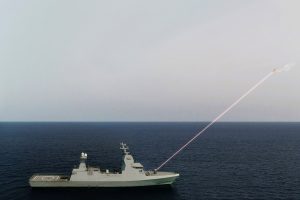
IMDEX 2023 – Rafael unveils its Naval Iron Beam
Developed by the Israeli company leveraging the work done on the land version, the Naval Iron Beam will be available in 4-5 years in two configurations, integrated in the ship or stand-alone
At IMDEX Asia, the International Maritime Defence Exhibition and Conference, taking place May 3-5 at the Changi Exhibition Centre in Singapore, Rafael of Israel unveiled a series of systems dedicated to ship protection. Leveraging the development of its Iron Beam, the land-based laser effector, the Haifa-based company developed the Naval Iron Beam, meant to be installed on naval ships to protect them against a series of threats, this type of effector being particularly suited to cope with saturation attacks such as those carried out by swarms of drones. First planned application being the future Reshef class corvettes of the Israeli Navy.

Exploiting the testing and live firing campaigns already conducted on the land-based version, Rafael has focused its activities on the specific maritime environment, conducting a series of laboratories and field testing to better understand how the direct energy weapon would react in that environment, which creates a series of challenging phenomena in addition to functional integration activities, influencing the effectiveness of the new weapon system.
Rafael has also been working on the stabilisation issue, a key point in a laser weapon which energy must be concentrated on the target for some time. The system has been developed and tested, the iam being to ensure the same accuracy obtained with the land version.
Having the land-based version almost reached the completion of testing activities with the system prototype reaching TRL 7, Rafael has recently launched the production of series representatives and expects to have this version available for operational use in a three-year time window. According to the company, the naval version will take 4 to 5 years to reach operational availability.
The naval version is based and maintains the same turret external dimensions and footprint as well as system architecture and components of the land application, allowing high commonality, while the laser power source varies according to the customer and requested application.

Rafael is working closely with the Israeli Navy and MoD for this naval version and the first application in the integrated configuration for the service is expected to be fitted on the new generation Reshef class corvette. The company is participating to the basic design phase of the new ships to integrate the system into the combat suite since the early stages, in order to optimize onboard spaces, energy power request and system installation in a naval platform of at least 1,000 tonnes displacement.
The Naval Iron beam has an emitting power of 100 kW, which gives it the ability to neutralise targets from a few hundred metres up to several kilometres.
A key issue in laser weapons is pinpoint accuracy, to ensure maximum energy transfer on the target. The Naval Iron Beam employs a medium-wave infrared course-tracking sensor which variable field-of-view (FoV), high frame rate, low latency, and high sensibility ensures maximum tracking precision. The beam director features also other optical channels, the fine tracking one being based on a near-IR high-frame rate with a very narrow FoV and low latency, while the laser illuminator unit uses a fibre-coupled laser diode working in the near-IR band. A colour day camera with zoom is used mainly for daylight surveillance tasks, while a laser rangefinder completes the suite.
The naval version comes into two main configurations: one integrated onto the ship superstructures and the other on containerized modules to be embarked when needed. The integrated version will have only the laser turret visible outside the superstructure, the laser source and cooling system being located immediately underneath within the structure, while batteries can be located elsewhere, their charge being ensured by the ship power distribution system. This reduces the impact of the system integration on board the ship. The stand-alone version is made of two modules, each hosted in a 20-foot container. The main module hosts the laser source and one or two turrets, depending on customers’ choice. The auxiliary module contains the diesel power generator with its fuel tank and the cooling system, the two containers being installed at short distance one from the other. This solution allows to deploy the system keeping it totally independent from the ship. According to Rafael, the 100 kW naval version weighs 2,000 kg, without considering the batteries, their capacity depending on customers’ requirements.
Photos and images courtesy L. Peruzzi and Rafael



